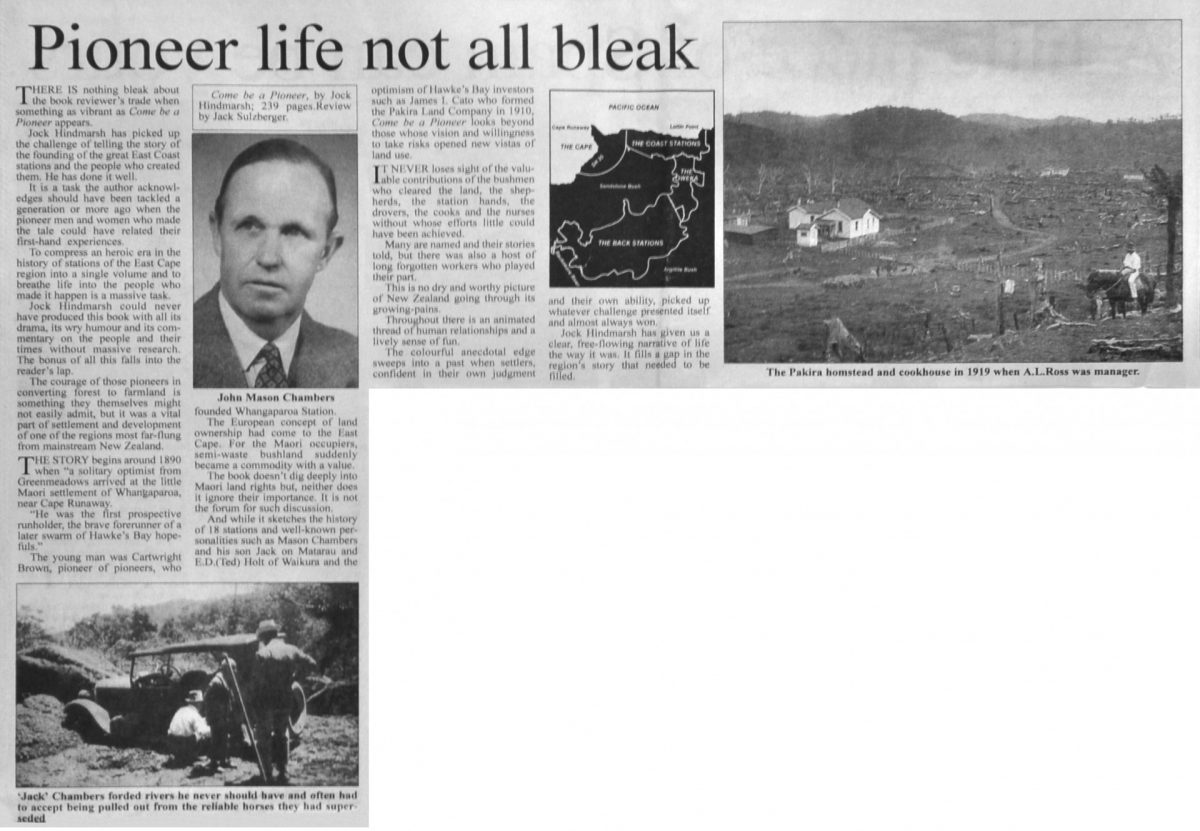Pioneer life not all bleak
Come be a Pioneer, by Jock Hindmarsh; 239 pages. Review by Jack Sulzberger.
THERE IS nothing bleak about the book reviewer’s trade when something as vibrant as Come be a Pioneer appears.
Jock Hindmarsh has picked up the challenge of telling the story of the founding of the great East Coast stations and the people who created them. He has done it well.
It is a task the author acknowledges should have been tackled a generation or more ago when the pioneer men and women who made the tale could have related their first-hand experiences.
To compress an heroic era in the history of stations of the East Cape region into a single volume and to breathe life into the people who made it happen is a massive task.
Jock Hindmarsh could never have produced this book with all its drama, its wry humour and its commentary on the people and their times without massive research. The bonus of all this falls into the reader’s lap.
The courage of those pioneers in converting forest to farmland is something they themselves might not easily admit, but it was a vital part of settlement and development of one of the regions most far-flung from mainstream New Zealand.
THE STORY begins around 1890 when “a solitary optimist from Greenmeadows arrived at the little Maori settlement of Whangaparoa, near Cape Runaway.
“He was the first prospective runholder, the brave forerunner of a later swarm of Hawke‘s Bay hopefuls.
The young man was Cartwright Brown, pioneer of pioneers, who founded Whangaparoa Station.
The European concept of land ownership had come to the East Cape. For the Maori occupiers, semi-waste bushland suddenly became a commodity with a value.
The book doesn’t dig deeply into Maori land rights but neither does it ignore their importance. It is not the forum for such discussion.
And while it sketches the history of 18 stations and well-known personalities such as Mason Chambers and his son Jack on Matarau and E.D. (Ted) Holt of Waikura and the optimism of Hawke’s Bay investors such as James I. Cato who formed the Pakira Land Company in 1910, Come be a Pioneer looks beyond those whose vision and willingness to take risks opened new vistas of land use.
IT NEVER loses sight of the valuable contributions of the bushmen who cleared the land, the shepherds, the station hands, the drovers, the cooks and the nurses without whose efforts little could have been achieved.
Many are named and their stories told but there was also a host of long forgotten workers who played their part.
This is no dry and worthy picture of New Zealand going through its growing-pains.
Throughout there is an animated thread of human relationships and a lively sense of fun.
The colourful anecdotal edge sweeps into a past when settlers, confident in their own judgment and their own ability, picked up whatever challenge presented itself and almost always won.
Jock Hindmarsh has given us a clear, free-flowing narrative of life the way it was. It fills a gap in the region‘s story that needed to be filled
Photo captions –
John Mason Chambers
The Pakira homestead and cookhouse in 1919 when A.L. Ross was manager.
‘Jack’ Chambers forded rivers he never should have and often had to accept being pulled out from the reliable horses they had superseded.












Do you know something about this record?
Please note we cannot verify the accuracy of any information posted by the community.